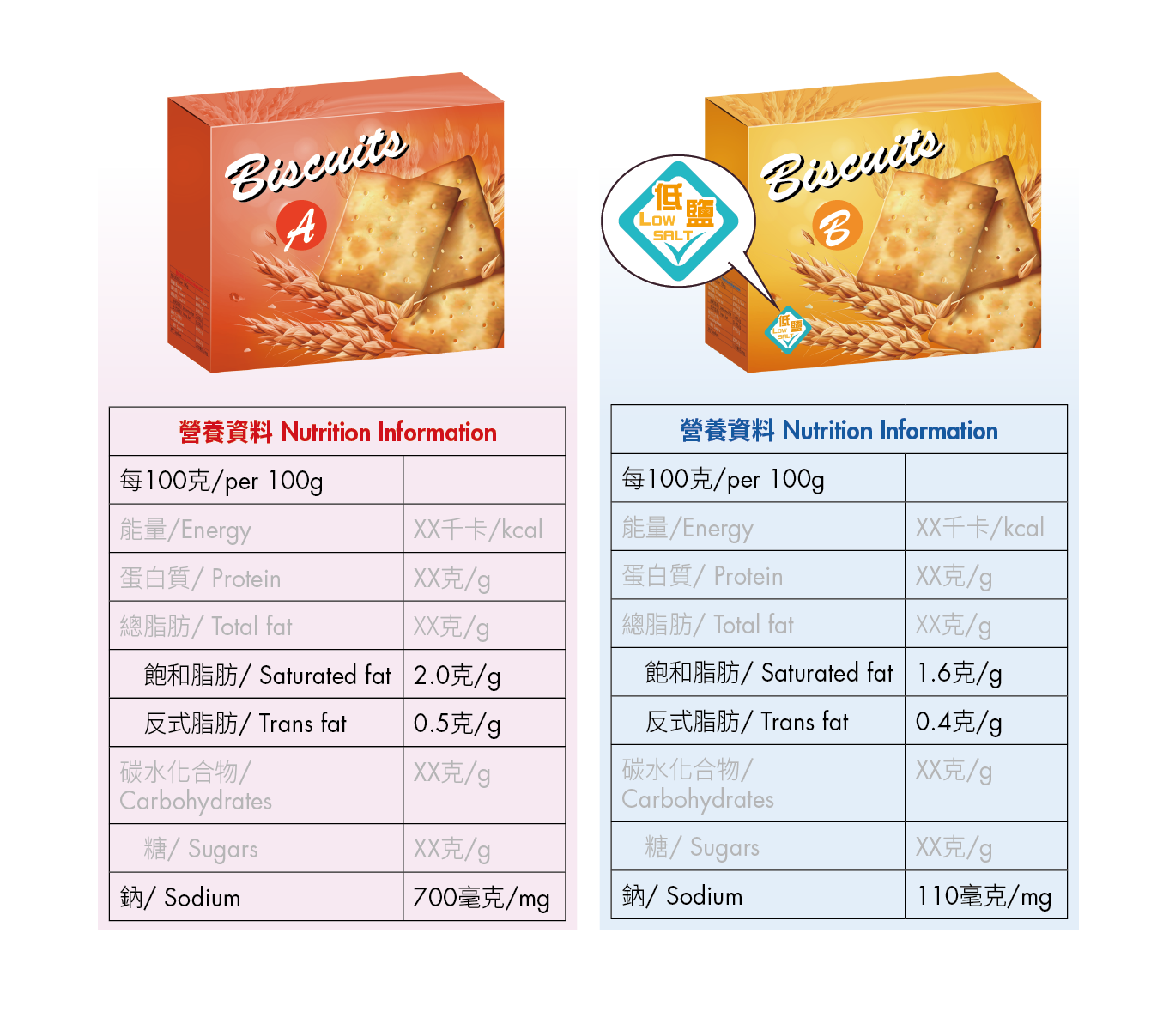
Food Safety Focus (147th Issue, October 2018) – Food Safety Platform
Read Nutrition Labels for Preventing Hypertension and Coronary Heart Disease
Reported by Ms Amy Leung, Dietitian, and Dr Violette LIN, Scientific Officer,
Risk Assessment Section, Centre for Food Safety
Nutrition labels on prepackaged foods are a tool that helps us in achieving healthy eating. In the last article, we discussed how to read the labels and choose a healthier food for preventing diabetes and obesity. In this article, we talk about the World Health Organization (WHO)'s dietary advice on preventing hypertension and coronary heart disease (CHD) as well as the use of nutrition labels on these conditions.
Hypertension and CHD
Sodium is one of the key factors affecting blood pressure. Excessive sodium intake increases the risk of developing high blood pressure. Also, eating too much food high in fat (especially saturated fat and trans fat), sodium, and sugar (see previous issue) increases the risk for CHD. To prevent hypertension and CHD (and its risk factor such as hyperlipideamia), we should follow a balance diet, maintain optimal body weight and waist circumference, and adopt a healthy lifestyle.
WHO's Dietary Advice on Preventing Hypertension and CHD
To prevent hypertension and CHD, the WHO advises that an adult should limit diary sodium intake to less than 2000 mg which is slightly less than one teaspoon of stle. Moreover, the daily energy intake from saturated fat and trans fat should be less than 10% and 1%, respectively of total energy intake. While individual intake amounts may be higher or lower depending on energy requirements, an adult with a 2000-kcal diet, for example, should get no more than 20g and 2.2g of saturated fat and trans fat, respectively.

Two packs of biscuits with different sodium, saturated fat and trans fat contents.
Use of Nutrition Labelling
Some prepackaged foods may be high in sodium (salt) (e.g. salted nuts, chips, ham), others in saturated fat (e.g. sausages, cured meats) and trans fat (e.g. margarine, pastry). Both saturated fat and trans fat raise the bad cholesterol level in blood. Trans fat also lowers the good cholesterol in blood. Look for these nutrients (sodium, saturated fat and trans fat) when reading nutrition labels if you are concerned about hypertension and CHD. The goal is to choose a food lower in these three nutrients.
Let's practise choosing foods with low or lower sodium, saturated fat and trans fat by using two packs of biscuits with hypothetical nutrient profile as an example according to the three tips below.
Tip 1: Any Nutrient Content Claim on a Product?
Some labels of prepackaged food contain claims such as “low salt”, “no salt”, “low saturated fat” or “trans fat free”. They are required to meet the legal claim conditions of “low” or “no” of the mentioned nutrients. To facilitate the public to select foods with less salt or sugar, some products may display the labels under the “Salt / Sugar” Label Scheme for Prepackaged Food Products. In this example, Biscuits B with the claim “Low Salt” is a better choice than Biscuits A.
Tip 2: Which Product Has Lower Salt, Saturated Fat or Trans Fat?
You can compare the biscuits for nutrient content. Use the same reference amount (e.g. sodium content per 100g) when making comparison. It is better to choose one with lower sodium, saturated fat and trans fat more often. In this example, Biscuits B is a better option than Biscuits A because of lower sodium, saturated fat and trans fat. Remember conversion is required if they are of different reference amounts (e.g. one product in per 100g and another in per serving).
Tip 3: How Much Salt, Saturated Fat and Trans Fat Intake Contributed by the Product?
No matter which pack of biscuits is chosen, compare the nutrients intake with the daily intake, and consider the intake of these nutrients from other foods in a day. In this example, 100g of Biscuits B contributes 5.5% (i.e. 110mg/2000mg), 8% (i.e. 1.6g/20g) and 18% (i.e. 0.4g/2.2g) of your daily sodium, saturated fat and trans fat intake limits, respectively.
In summary, to prevent hypertension and CHD, use the nutrition label and choose a food that is lower in sodium and lower in combined amount of saturated fat and trans fat, and read the nutrition labels according to your needs.


